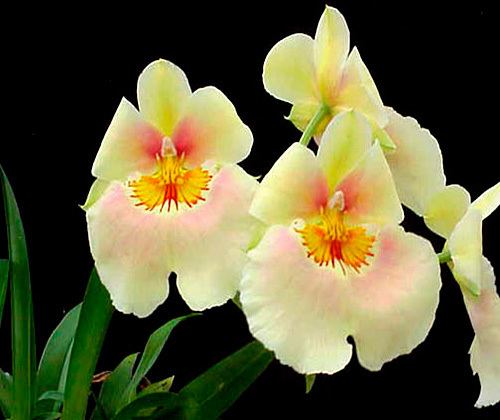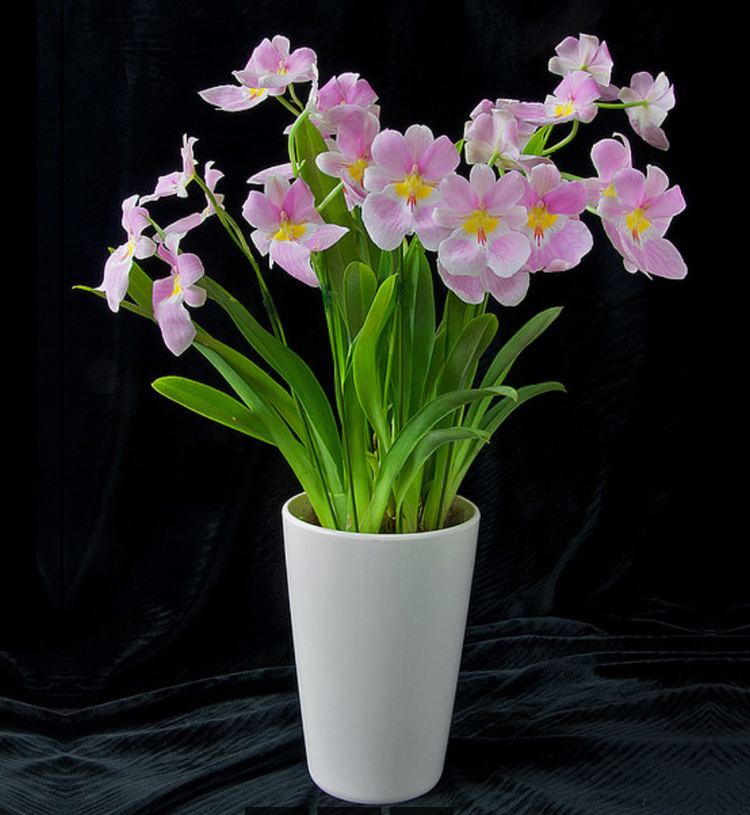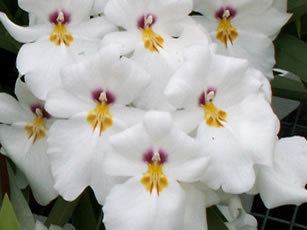Scientific name Miltonia Rank Genus | ||
 | ||
Lower classifications Miltonia spectabilis, Miltonia flavescens, Miltonia liana, Miltonia clowesii, Miltonia regnellii | ||
Repotting miltonia
Miltonia, abbreviated Milt. in the horticultural trade, is an orchid genus formed by nine epiphyte species and eight natural hybrids inhabitants of the Brazilian Atlantic Forest, one species reaching the northeast of Argentina and east of Paraguay. This genus was established by John Lindley in 1837, when he described its type species, Miltonia spectabilis. Many species were attributed to Miltonia in the past, however, today, the species from Central America and from cooler areas on northwest of South America have been moved to other genera. Miltonia species have large and long lasting flowers, often in multifloral inflorescences. This fact, allied to being species that are easy to grow and to identify, make them a favorite of orchid collectors all over the world. Species of this genus are extensively used to produce artificial hybrids.
Contents
- Repotting miltonia
- How to take care of miltoniopsis miltonia orchids semi hypodronics seramis clay pebbles
- Distribution
- Description
- Species
- Natural hybrids
- Culture
- Intergeneric hybrids
- References

Despite the fact that Miltonia is now a well established genus, most of its species were originally classified under other genera as Cyrtochilum, Oncidium, Odontoglossum, and Brassia. All were discovered between 1834 and 1850 with the exception of M. kayasimae, discovered only in 1976.

These epiphytic orchids occur from Central to Southern Brazil down to Argentina.
These orchids have two leaves, arising from a pseudobulb, covered with a foliaceous sheath. The inflorescence consists of waxy, nonspurred flowers. The lip is large and flat and lacks a callus at its base. They possess a footless column with two hard pollinia. The flowers have a delicate, exotic scent, some compare to that of roses.

They are named after Charles Wentworth-Fitzwilliam, 5th Earl Fitzwilliam, formerly Viscount Milton, an English orchid enthusiast.
The species in this genus are sometimes referred to as the pansy orchids, but it is the Miltoniopsis orchids that have flowers that closely resemble the pansy. Almost everyone except for the most serious orchid hobbyists use the name pansy orchids interchangeably, which may cause confusion.

Miltonia looks more like Oncidiums than the other pansy orchids. The most "pansy-like" a Miltonia can get is the species Miltonia spectabilis. Taxonomists are debating whether to put Miltonia into the Oncidium genus because of the many connections between the two.
Miltoniopsis is the pansy orchid with huge showy flowers. They grow in cooler climates and are more challenging to grow than Miltonia.
This genus forms with Miltoniopsis a hybrid genus xMilmiltonia J.M.H.Shaw.
How to take care of miltoniopsis miltonia orchids semi hypodronics seramis clay pebbles
Distribution
Miltonia species range starts on the area of Missiones in the northeast of Argentina and east of Paraguay and spreads north along the Brazilian mountains of Serra do Mar and its branches up to the State of Pernambuco on Brazilian northeast. They occupy mostly areas between 200 and 1,500 meters of altitude meters, however the majority of the species are more often found about 600 to 900 meters. Miltonia species can be found from shady areas inside the forest to areas more exposed to the sun, however never are under full sunlight; usually in ventilated places where they receive plenty humidity during the night and early morning. They are always epiphyte and, because they grow very fast, each pseudobulb originating two new growths every year, they soon form large colonies.
Miltonia russelliana and M. flavescens are the ones with the widest dispersion and found at lower altitudes. M. flavescens is the only species that exists in countries other than Brazil and is also the one that spreads farther north. M. russelliana range starts on Rio Grande do Sul and ends at Bahia State. M. regnellii is also widespread although does not go northern than Rio de Janeiro. M. moreliana is a species more common at lower altitudes and warmer areas existing from Rio to Pernambuco. Miltonia candida, M. clowesii and M. spectabilis are restricted to the four states of Region Southeast of Brazil. Miltonia cuneata is just from São Paulo and Rio and the one that grow at highest altitudes. M. kayasimae is the only species really rare; it has been found just a couple of times in a very restricted area close to Salesópolis, in São Paulo State. The mountains area between São Paulo and Rio de Janeiro, where almost all species do exist may be considered the center of distribution of Miltonia.
Description
Miltonia are comparatively medium large orchid plants reaching about fifty centimeters height. They present subcaespitous growth, that means their pseudobulbs are not tightly packed but slightly spaced by a rhizome, that is longer than on caespitous plants, with length between two and five centimeters. Their roots grow along the rhizome in high numbers. They are white, comparatively thin, usually short and hardly branched. The rhizome is covered by dried imbricating steaths which get increasingly larger at the base of pseudobulb becoming articulated foliar steaths that partially cover them. The pseudobulbs and leaves vary in color from yellowish bright light green to olive green depending on the species and to the amount of sunlight they are exposed to. They may be more oval and laterally highly flattened to slightly tetragonal and elongated and almost always bear two apical leaves. The leaves are narrow, flexible and hardly larger than three centimeters wide and forty long with the apexes rounded sometimes slightly pointed. Some species are about half of this size. The inflorescences are one or two per pseudobulb, shoot from their bases behind the protecting steaths. They are erect and never branched, often longer than the leaves, bearing from one to twelve moderately spaced flowers that open at the same time or in succession holding three or four opened all the time, when the older fades a new one opens. The older flowers of species with white lips that open in succession usually get yellower about the time the next flower opens although they still last one more week before fading. The first to bloom is M. cuneata, during late winter, but the majority of species bloom from late spring to late summer.
The flowers of Miltonia vary from four to fifteen centimeters across; the larger are the ones with fewer flowers. Their colors vary from entirely white and pink to dark purple, pale yellow or lilac when plain, or they may highly spotted but then usually they are greenish or brownish with a contrasting labellum often white with purple dots, stains or veins close to the base. The petals and sepals shapes are highly variable from species to species but always somewhat similar to each other within a species. They may be erect and flat or sometimes less open. The labellum is simple or very slightly lobed, usually very wide and showy without salient calli although normally showing more or less subtle keeled thickenings close to the base, usually of different colors; it is much larger and wider than the other segments, often flat but in M. candida embraces the column and in all species it is slightly fused to the column at their bases. The short column does not have a foot and presents two lateral auricles sometimes merged to each other through a fringe that surrounds the superior edge of the clinandrium. The anther is apical and bears two yellow hard pollinia. They possibly are pollinated by bees.
Species
The species of Miltonia show many differences to each other are very easy to identify, therefore, just the most evident differences are mentioned here; more details are given on individual species articles. The species are presented here according to their morphology and this order keeps no correspondence with phylogenetic relationships.
Regarding vegetative morphology Miltonia moreliana and Miltonia spectabilis can be immediately separated from the rest because their much flatter pseudobulbs, longer rhizome and inflorescences completely covered by flattened bracts that bear only one highly flat flower. These are the species with largest flowers in the genus. They are closely related and usually are recognized because the flowers of M. moreliana usually have dark purple petals and sepals and the lip of a lighter bright purple while M. spectabilis has very light purple or white petals and sepals and a purple veined labellum, however, the real technical difference among the species is on the proportions of their segments which are much wider. Despite colors are often mentioned to identify species they are not accepted by taxonomy as enough to establish distinct species by themselves. All other Miltonia species have similar vegetative appearance and only can be positively identified by their flowers.
Three species are unique: Miltonia flavescens has the most narrow flowers, almost star shaped, with all segments of straw color with some purple bots on the base of petals and sepals which are more intense on the labellum almost forming stripes; Miltonia candida is the only species with a labellum that embraces the column in a way that reminds the Cattleya species; Miltonia russelliana is the less showy of Miltonia species because its sepals and petals do not really open, being always bent over the column, revealing only the lighter tip of its purple labellum.
Miltonia regnellii shows the widest flower color variation among all Miltonia species; they can vary from white to yellow, pink and lilac with labelli also varying from white to dark purple. The flowers open in succession and slightly resemble the ones of M. spectabilis although much smaller. They actually are the Miltonia species with the smallest flowers.
Miltonia kayasimae and Miltonia cuneata are somewhat similar and possibly are closely related, both have straw color petals and sepals almost entirely covered by large brown stains and white labelli, however, they show different proportions on the flowers segments. M. kayasimae has much wider petals and sepals and smaller labellum which, moreover, has a larger and more salient and complex entirely purple callus on its base which is delicate, more straight and simple, and just occasionally purple dotted on its apex on M. cuneata.
Miltonia clowesii has the same color pattern of M. russelliana with light yellow greenish brown sepals and petals completely covered with large darker dots or stains and labellum of bright purple at the base and lighter apex, however here they are whiter. On the other hand, M. clowesii flowers' pointed segments are larger and wide opened making it resemble a spider.
Natural hybrids
Considering its limited number of species, it is surprising that eight natural hybrids of Miltonia are currently known, a number that almost equals the number of species and also implies that the most important pollinator of the majority of the species possibly is the same. As the crossing of two species uses to produce variable plants most of these hybrids have been described more than once and some have three or four synonyms. M. spectabilis is the species which has produced the largest number of hybrids, five: Miltonia × bluntii when crossed with M. clowesii, Miltonia × cogniauxiae with M. regnellii, Miltonia × flava with M. flavescens, Miltonia × leucoglossa with M. candida and Miltonia × rosina with M. cuneata, furthermore it is possible there is also one with M. moreliana, which has not yet been described because M. moreliana itself was earlier considered a variety of M. spectabilis.
M. candida, besides the hybrid already mentioned with M. spectabilis, also produced two others: Miltonia × binotii with M. regnellii and Miltonia × lamarckeana with M. clowesii. The remaining hybrid, Miltonia × peetersiana was previously considered a synonym of M. × bluntii but because M. moreliana is now a species distinct from M. spectabilis it is its hybrid with M. clowesii, which has entirely purple flowers instead the one with light brown petals and sepals.
Culture
Despite being easy to grow, Miltonia species tend to be subject to spots on their thin leaves, generally caused by fungi proliferation and normally, when exposed to the amount of light they need to a full bloom, their foliage gets a bit too yellow-colored, although they should never be exposed to full sunlight. Finding the right balance of light exposure to avoid yellow leaves but still produce nice blooming is important and with some precautions the grower will succeed. They are not terribly sensitive to temperature, but they do vary according to their species make-up and origin; M. cuneata being one that grows cooler and M. moreliana the warmer growing, but all species under intermediate temperature with at least 10 °C of variation between day and night. Despite the fact that they exhibit a rest period after blooming, Miltonia always need to be watered, and more abundantly during active growth and blooming. they need at least 65% relative humidity and good ventilation all the time. Moderate weekly fertilizing with a balanced formula is beneficial during active growth. They may be potted in a compost of half-chopped Sphagnum, peat, and some medium-sized lumps of charcoal, or mounted on plaques of vegetable fiber, however if mounted they will need more frequent waterings.
